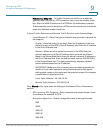
Configuring VPN
Configuring Basic Site-to-Site IPsec VPN Settings
Cisco RV215W Wireless-N VPN Firewall Administration Guide 105
9
To configure basic VPN settings for a site-to-site connection:
STEP 1 Choose VPN > Basic VPN Setup.
STEP 2 In the Connection Name field, enter a name for the VPN tunnel.
STEP 3 In the Pre-Shared Key field, enter the pre-shared key, or password, that will be
exchanged between the two routers. It must be between 8 and 49 characters.
STEP 4 In the Endpoint Information fields, enter the following information:
• Remote Endpoint—Choose the way the remote endpoint, or the router to
which the device will connect, is identified. For example, by an IP address
such as 192.168.1.1, or by a fully qualified domain name such as cisco.com.
• Remote WAN (Internet) IP Address—Enter the public IP address or domain
name of the remote endpoint.
• Redundancy Endpoint—To enable the device to switch to an alternate
gateway when the primary VPN connection fails, check the Enable check
box. Enter the WAN IP address or the FQDN for the redundancy endpoint.
• Local WAN (Internet) IP Address—Enter the public IP address or domain
name of the local endpoint (device).
STEP 5 In the Secure Connection Remote Accessibility fields, enter the following
information:
• Remote LAN (Local Network) IP Address—Enter the private network
(LAN) address of the remote endpoint. This is the IP address of the internal
network at the remote site.
• Remote LAN Subnet Mask—Enter the private network (LAN) subnet mask
of the remote endpoint.
• Local LAN (Local Network) IP Address—Enter the private network (LAN)
address of the local network. This is the IP address of the internal network
on the device.
• Local LAN (Local Network) Subnet Mask—Enter the private network (LAN)
subnet mask of the local network (device).
Note: The remote WAN and remote LAN IP addresses cannot exist on the same
subnet. For example, a remote LAN IP address of 192.168.1.100 and a local LAN
IP address of 192.168.1.115 would cause conflict when traffic is routed over the
VPN. The third octet must be different so that the IP addresses are on different
subnets. For example, a remote LAN IP address of 192.168.1.100 and a local
LAN IP address of 192.168.2.100 is acceptable.


















